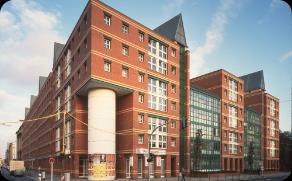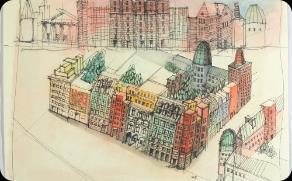"Aldo Rossi: Architect of Collective Memory and Urban Identity"
AldoRossiwasarenownedItalianarchitect andurbantheoristwhomadesignificant contributions tothefieldofarchitectureand urbandesign.Hisinnovative approachto citiesandtheirdevelopmentshapedthe postmodernarchitecturalmovementand influencedgenerationsofdesigners andplanners.
Aldo Rossi's Background and Education
Early Life
Rossi was born in 1931 in Milan, Italy, and grew up in the city, which would later greatly influence his architectural and urban design philosophies.
Education
He studied architecture at the Polytechnic University of Milan, where he developed his interest in urban theory and the study of cities
Professional Career
After completing his studies, Rossi began his professional career, working on various projects and teaching at universities, including the Polytechnic University of Milan.
Rossi's Contribution
to Urban Design Theory
The Architecture of the City Rossi's seminal work, "The Architecture of the City," published in 1966, challenged the prevailing modernist approach to urban design and proposed a more contextual and historical understanding of cities
Collective Memory
Rossi believed that the collective memory of a city, embodied in its physical structures and urban fabric, was a crucial factor in shaping its identity and development
Typology and Morphology Rossi's theories on urban typology and morphology, which explored the relationship between building types and urban form, were highly influential in the field of urban design
1 The Idea of the City Rossi believed that the city is a living entity, with its own history, culture, and collective memory, which should guide its design and development.
3 Typology and Morphology
Rossi's theories on urban typology and morphology explored the relationship between building types and urban form, and their influence on the identity of a city.
2 Permanence and Change
He recognized the tension between the permanence of urban structures and the need for change, and sought to balance these elements in his approach to urban design.
4 Analogous City
The concept of the "analogous city" referred to Rossi's belief that cities contain inherent patterns and relationships that can be used to inform new urban design interventions.
Rossi's Influence on the Postmodern Architecture Movement
Aldo Rossi's pioneering urban design theories had a profound impact on the emergence of the Postmodern architecture movement His emphasis on contextual design, historical continuity, and the emotive power of architecture inspired a generation of architects to challenge the dogma of Modernism
Analysis of Rossi's Seminal Works and Projects
Aldo Rossi's most celebrated works exemplify his unique approach to urban design, blending historical context with innovative architectural forms His iconic buildings, such as the Cemetery of San Cataldo in Modena and the Palazzo della Ragione in Verona, showcase his mastery of typology and symbolism
Rossi's designs often featured recurring motifs, like the arcaded facades and cubic massing that became hallmarks of his style His influential writings, including the seminal treatise "The Architecture of the City," further articulated his revolutionary vision for the built environment
Rossi's Approach to Urban Renewal and Redevelopment
Preservation of HistoricFabric
Rossi advocated for the sensitive preservation and adaptive reuse of existing historic buildings and urban structures, rather than wholesale demolition and redevelopment.
Contextual Redevelopment
Rossi believed new developments should harmonize with the existing urban fabric, drawing inspiration from the typology and morphology of the surrounding environment.
Prioritizing
Public Realm
Rossi's approach emphasized the importance of highquality public spaces and communal areas as the heart of a thriving urban community.














